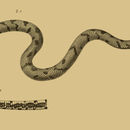ar
الأسماء في صفحات التنقل


Like other species of the genus it is largely nocturnal.
Endangered
A medium-sized, fairly slender snake. Largest Egyptian specimen has a total length of 1,021 mm. Tail short, tail / total length = 0.09-0.15; nostril in a partly divided nasal; loreal elongate, entering the eye below a preocular; 7-9 supralabials, third, fourth and fifth enter the eye; eye rather small, iris dark, pupil vertical; 214-223 ventrals, 51-59 paired subcaudals, dorsals smooth, 19 scale rows around mid-body, anal divided (based on 3 Egyptian specimens). Dorsum gray, with about 40 thin, blackish, transverse bands (between neck and vent); head and neck black, both dorsally and ventrally, with fine white and gray specks. Venter lighter gray covered with a wide, longitudinal, blackish band. The dorsal bars become reduced and indistinct in adult animals.
All documented Egyptian material appears to come from the general St. Katherine area (Schmidt and Marx 1956, Werner 1988). One further juvenile specimen was found in Wadi El Sheikh in September 2000. Professional collectors of Abu Rawash claim that the specimen Saleh (1997) depicts actually came from Gebel Maghara and not "Southern Sinai mountains" as reported. The reduced number of dorsal transverse bars (not more than 30 between neck and vent) supports the proposal that this specimen came from a northern locality.
Endemic to a small geographic area, which encompasses Sinai, the Negev, and has most recently been reported from western Jordan.
Not much information available. The few specimens available from Sinai were collected from lightly vegetated hilly and mountainous regions among rocks. A traffic casualty found in September 2000 was crossing a wide gravelly plain with steppe-like vegetation.
Rare and localized. Reported from the pet trade a couple of times.
Telescopus hoogstraali, common names of which include Hoogstraal's cat snake and the Sinai cat snake,[1] is an endangered cat snake species of the family Colubridae. The species is endemic to the Middle East.
The specific name, hoogstraali, is in honor of American entomologist and parasitologist Harry Hoogstraal.[4]
T. hoogstraali has a black-coloured neck and head. Its eyes are small with vertical, cat-like pupils. The snake's underbelly is grey and is covered with black spots.[5]
T. hoogstraali is found around the Sinai region, in Egypt and Israel, as well as Jordan.
In Egypt, it is found in Santa Catarina and Gebel Maghara of northern Sinai Peninsula, while in Israel it can be found only in Negev Desert. It is also known from one city in Jordan, Petra.[1]
T. hoogstraali can be found at an elevation of 1,500 metres (4,900 ft) in natural habitats such as subtropical or tropical dry shrubland, subtropical or tropical dry lowland grassland, rocky areas, and hot deserts.[1]
T. hoogstraali is threatened by habitat loss and distribution.[1]
Telescopus hoogstraali, common names of which include Hoogstraal's cat snake and the Sinai cat snake, is an endangered cat snake species of the family Colubridae. The species is endemic to the Middle East.
Telescopus hoogstraali Telescopus generoko animalia da. Narrastien barruko Colubridae familian sailkatuta dago.
Telescopus hoogstraali Telescopus generoko animalia da. Narrastien barruko Colubridae familian sailkatuta dago.
Telescopus hoogstraali est une espèce de serpents de la famille des Colubridae[1].
Cette espèce se rencontre[1] :
L'holotype de Telescopus hoogstraali[2], un mâle, mesure 993 mm dont 153 mm pour la queue. Cette espèce a une tête entièrement noire. Son dos est gris sombre avec de fines rayures sombres. Sa face ventrale est clair tacheté de noir et présentant une large bande médiane sombre.
Cette espèce est nommée en l'honneur de Harold Hoogstraal (1917–1986) qui a collecté le spécimen étudié[2].
Telescopus hoogstraali est une espèce de serpents de la famille des Colubridae.
Telescopus hoogstraali – gatunek bliskowschodniego węża z rodziny połozowatych.
Populacja zamieszkująca Jordanię zaliczana bywa do osobnego podgatunku[1].
Lepidozaury te zalicza się do rodziny połozowatych[1], do której zaliczano je od dawna. Starsze źródła również umieszczają Telescopus w tej samej rodzinie Colubridae, używając jednak dawniejszej polskojęzycznej nazwy: wężowate albo węże właściwe. Poza tym Colubridae zaliczają do infrapodrzędu Caenophidia, czyli węży wyższych. W obrębie rodziny rodzaj Telescopus należy natomiast do podrodziny Colubrinae[2].
Telescopus hoogstraali występuje na Bliskim Wschodzie. W Egipcie spotyka się go w północnej części Synaju (dokładniej Gebel Maghara), zamieszkuje też południową część półwyspu Synaj (Santa Catarina). W Izraelu żyje na pustyni Negew. Populacja jordańska, uważana niekiedy za osobny podgatunek, zamieszkuje okolice Petry[1].
Tereny, na których żyje ten połozowaty, leżą na wysokości nie przekraczającej 1500 m n.p.m. Są to pustynne stepy, na których rocznie spada 10-15 cm opadów atmosferycznych[1].
Jest to gad rzadki, a jego liczebność ulega zmniejszaniu się. IUCN nie ma danych na temat zagrożeń panujących w Izraelu, w Egipcie wymienia natomiast wypas zwierząt, górnictwo, śmierć na drogach, zbiórkę drewna na opał, nadmierny odłów w celach naukowych[1].
Występuje w dwóch obszarach chronionych (Santa Catarina, Dana Wildlife Reserve)[1].
 Alethinophidia
Alethinophidia Telescopus hoogstraali – gatunek bliskowschodniego węża z rodziny połozowatych.
Telescopus hoogstraali là một loài rắn trong họ Rắn nước. Loài này được Schmidt & Marx mô tả khoa học đầu tiên năm 1956.[1]
Telescopus hoogstraali là một loài rắn trong họ Rắn nước. Loài này được Schmidt & Marx mô tả khoa học đầu tiên năm 1956.